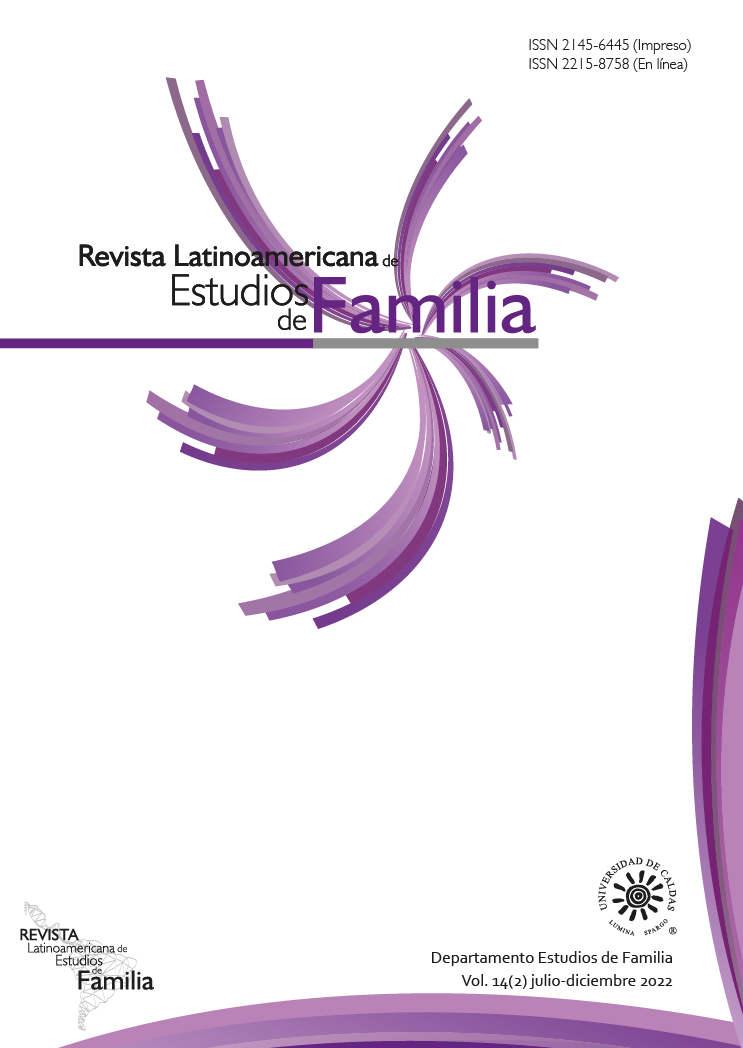Autores/as
Resumen
Resumen: Objetivo. Este estudio parte de una investigación exploratoria y descriptiva sobre familias mixtas en China donde uno de los conyugues es local y el otro proviene de un país latinoamericano. Metodología. La metodología responde a un abordaje cualitativo y la recolección de datos se realizó con
entrevistas en diferentes ciudades chinas durante 2021. Resultados. Entre los principales resultados que surgen del campo podemos destacar diferentes perfiles de migrantes según las ciudades de origen, residencia y trayectoria, dos tipos de matrimonios mixtos latino-chinos y que la proyección de las parejas que fueron parte de la investigación es la de quedarse a vivir en China. Al mismo tiempo, entre los arreglos familiares nos detenemos en los hijos y puntualmente sobre las decisiones de la crianza y la nacionalidad que eligen para ellos. Conclusiones. Estas familias desarrollan sistemas matrimoniales y familiares en las que negocian y tensionan las características propias de sus culturas y de la especificidad de vivir en China en la actualidad.
Palabras clave
Citas
Baldassar, L., Kilkey, M., Merla, L. & Wilding, R. (2014) Transnational families. In J. Treas, J. Scott & M. Richards. (Eds.) The Wiley Blackwell Companion to the Sociology of Familie. (pp.155-175), John Wiley and Sons.
Barabantseva, E. (2011). Overseas Chinese, Ethnic Minorities and Nationalism: De-Centring China. London: Routledge.
Brettell, C. B. (2017). Marriage and Migration. Annual Review of Anthropology, 46(1), 81–97. https://doi.org/10.1146/annurev-anthro-102116-041237
Botton Beja, F. (2017).Tendencias actuales en el matrimonio en China. Estudios de Asia y África, 52(3), 535-566. https://doi.org/10.24201/eaa.v52i3.2301
Chen, J. & Takeuchi, D.T. (2011), Intermarriage, Ethnic Identity, and Perceived Social Standing Among Asian Women in the United States. Journal of Marriage and Family, 73(4), 876-888. https://doi.org/10.1111/j.1741-3737.2011.00853.x
Denardi, L. (2020). Chinese Migrations to Argentina: Diasporic Bureaucracy, Identifications and Rituals. In P. Baisotti (Ed), Chinese Immigration in Latin America: Some Cultural Contributions (pp. 69-88). Cambridge Scholars Publishing
Ding, J., Hongyan, Y., Shaoyun, Z., Jixiang, Z., Kewu, L. & Yuzhi, Z. (2004). Characteristics and trends or cross nation marriage in modern Shanghai. Chinese Journal of Population Science 3, 66-80.
Farrer, J. (2008). From “Passports” to “Joint Ventures”: Intermarriage between Chinese Nationals and Western Expatriates Residing in Shanghai. Asian Studies Review, 32(1), 7-29. https://doi.org/10.1080/10357820701870742
Ganne, B. & Lu, S. (2011). Local Economic Development and Transformations of the Political Discourse and Practices in China: Case Analyses from the Zhejiang Region from the 1980s,
European Journal of East Asian Studies, 10(2), 203-226. http://www.jstor.org/stable/23615686
Hu, Y. (2017). Attitudes toward transnational intermarriage in China: Testing three theories of transnationalization. Demographic Research, 37, 1413-1444. https://doi.org/10.4054/DemRes.2017.37.44
Jeffreys, E. & Pan, W. (2013). The Rise of Chinese-Foreign Marriage in Mainland China (1979 – 2010). China Information, 27, (3) 347–69. https://doi.org/10.1177/0920203X13492791
Ji, Y. &Yeung, W. (2014). Heterogeneity in Contemporary Chinese Marriage. Journal of Family Issues, 35(12),1662-82. https://doi.org/10.1177/0192513X14538030
Ji, Y. (2020) Complexity of Chinese Family Life: Individualism, Familism, and Gender. The China Review, 20(2): 1-18. https://www.jstor.org/stable/26915619
Jordan, L., Pau Hoang, A., Chui, C., Wang, W. & Mazzucato, V. (2020): Multiple precarity and intimate family life among African-Chinese families in Guangzhou, Journal of Ethnic and Migration Studies, 47(12), 2796-2814. https://doi.org/10.1080/1369183X.2020.1739390
Krippendorff, K. (2018). Content analysis: An introduction to its methodology. Sage publications.
Laitila, A., Vall, B., Penttonen, M., Karvonen, A., Kykyri, V., Tsaysishvili, V., Kaartinen, J. & Seikkula, J. (2019). The added value of studying embodied responses in couple therapy research: A case study. Family Process, 58, 685-697. https://doi.org/10.1111/famp.12374
Lan, S. (2017). China gives and China takes. Focaal, 2017 (77), 50-62
Leonard, A. & Lehmann, P. (2019) Destination China. Inmigration to China in a Post-Reform Era. Palgrave Macmillan
Ling, M. (2015). Bad Students Go to Vocational Schools!: Education, Social Reproduction and Migrant Youth in Urban China. The China Journal, 73(73),108-131.
Lui, L. (2016). Gender, Rural-Urban Inequality, and Intermarriage in China. Social Forces, 95(2), 639-662. http://www.jstor.org/stable/26166845
Marsden, M. & Ibañez-Tirado, D. (2015) Repertoires of Family Life and the Anchoring of Afghan Trading Networks in Ukraine. History and Anthropology, 26(2), 145-164. https://doi.org/10.1080/02757206.2014.1002375
Nehring, D. & Wang, X. (2016). Making transnational intimacies: intergenerational relationships in Chinese-Western families in Beijing. The Journal of Chinese Sociology, 3(10), 1-24. https://doi.org/10.1186/s40711-016-0032-3
Osanami Törngren, S., Irastorza, N. & Song, M. (2016). Toward building a conceptual framework on intermarriage. Ethnicities, 16(4), 497–520. https://doi.org/10.1177/1468796816638402
Pieke, F. (2012). Immigrant China. Modern China, 38(1), 40-77. http://www.jstor.org/stable/23216934
Pimentel, E. (2004) Just How Do I Love Thee?: Marital Relations in Urban China. Journal of Marriage and family, 62(1), 32-47.
https://doi.org/10.1111/j.1741-3737.2000.00032.x
Sha, H. (2020) Transnational marriage in Yiwu, China: trade, settlement and mobility. Journal of Ethnic and Migration Studies, 46(11), 2326-2345. https://doi.org/10.1080/1369183X.2019.1675500
Wang, Y. & Schwartz, C. R. (2018). Hukou intermarriage and social exclusion in China. Research in social stratification and mobility, 56, 28–39. https://doi.org/10.1016/j.rssm.2018.06.002
Wang, X. & Nehring, D. (2014). Individualization as an ambition: mapping the dating landscape in Beijing. Modern China, 40(6),578604. https://doi.org/10.1177/0097700413517618
Wei-Jun, J. & Zheng, M (2020): Migration and marriage in Asian contexts. Journal of Ethnic and Migration Studies, 46(14), 2863-2879. https://doi.or/10.1080/1369183X.2019.1585005
Yang, H. (2017). Attitudes toward transnational intermarriage in China: Testing three theories of transnationalization. Demographic Research, 37, 1413-1444. https://doi.org/10.4054/DemRes.2017.37.44
Yang, P. & Bohm-Jordan, M. (2018) Patterns of Interracial and Interethnic Marriages among ForeignBorn Asians in the United States. Societies, 8(3), 87. https://doi.org/10.3390/soc8030087
Yeung, W.-J. J., & Mu, Z. (2019). Migration and marriage in Asian contexts. Journal of Ethnic and Migration Studies, 1–17. https://doi.org/10.1080/1369183x.2019.1585
Zang, X. & Zhao, L. (2017). State of the field: the family and marriage in China. In Z. Xiaowei & L.X. Zhao (Ed). Handbook on the Family and Marriage in China. (pp.1-19). Edward Elgar.
Zhou, Y. (2017). Intercultural Marriage, Legal Status and Social Belonging in China: Chinese-African Couples and Families in Guangzhou. [PhD Dissertation, Universitä̈t zu Köln, Germany]. https://kups.ub.uni-koeln.de/7709/

 PDF
PDF
 FLIP
FLIP

























